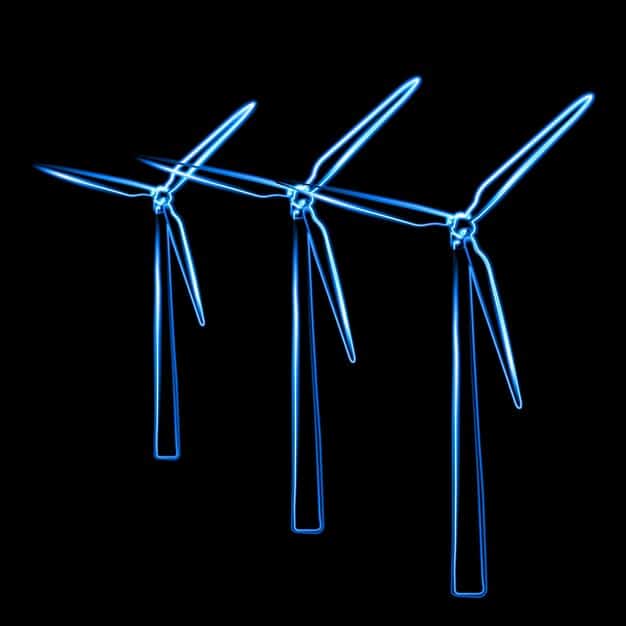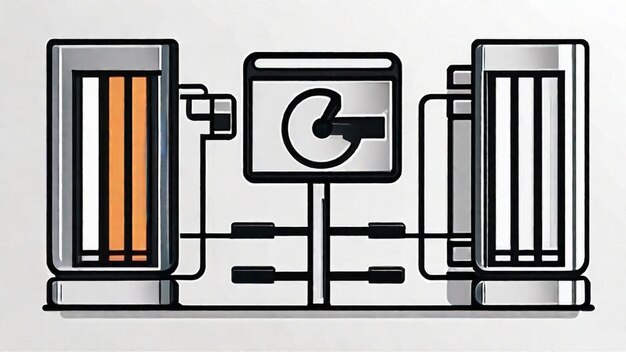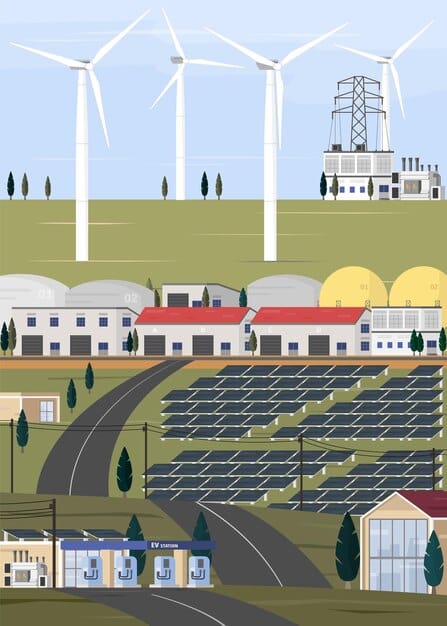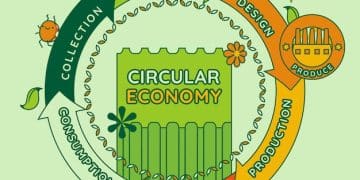Future of Renewable Energy in US: Trends & Opportunities 2025

Navigating the trajectory of renewable energy in the US for 2025 reveals a landscape evolving rapidly through policy, technological innovation, and investment, promising significant shifts in national energy reliance and economic opportunities.
The landscape of energy consumption and production is undergoing a profound transformation, and nowhere is this more evident than in the United States. As we approach 2025, the conversation around The Future of Renewable Energy in the US: Trends and Opportunities in 2025 is not just theoretical; it’s a dynamic reality shaping policies, industries, and daily lives. This pivotal moment is defined by accelerated adoption, innovative technologies, and a concerted push towards sustainability, offering a glimpse into a greener, more resilient energy infrastructure.
The policy landscape driving renewable energy in 2025
The trajectory of renewable energy in the US is inextricably linked to its policy environment. As 2025 approaches, federal, state, and local policies are creating a robust framework, accelerating the transition away from fossil fuels. These policies are not merely aspirational; they encompass a sophisticated array of incentives, regulations, and investment strategies designed to de-risk investments and foster innovation in the renewable sector.
Understanding these legislative underpinnings is crucial for anyone seeking to engage with the renewable energy market. The Inflation Reduction Act (IRA), passed in 2022, stands as a monumental piece of legislation, extending and expanding significant tax credits for renewable energy projects, electric vehicles, and energy efficiency. Its provisions are structured to incentivize domestic manufacturing and supply chains, further strengthening the US renewable energy industrial base.
Key policy drivers for growth
Several policy mechanisms are playing a crucial role in shaping the renewable energy market in 2025. These drivers are designed to provide long-term certainty and stimulate investment across various scales, from utility-scale projects to distributed generation. The stability offered by these policies is attracting significant private capital, a testament to their perceived effectiveness.
- Investment Tax Credits (ITCs) and Production Tax Credits (PTCs): Extended and enhanced under the IRA, these credits significantly reduce the upfront cost and ongoing operational expenses for solar, wind, and other renewable projects, making them more competitive against traditional energy sources.
- State-level Renewable Portfolio Standards (RPS): Many states have mandated that a certain percentage of their electricity come from renewable sources by specific deadlines. These standards create a consistent demand for renewable energy, driving market growth and technological advancements.
- Carbon Pricing and Emissions Reduction Targets: While a federal carbon price remains elusive, several states and regions are implementing their own carbon markets or setting ambitious emissions reduction targets. These initiatives create economic incentives for industries to decarbonize and shift towards cleaner energy solutions.
Furthermore, permitting reform, while often contentious, is gaining traction as a necessary step to accelerate the deployment of new renewable energy infrastructure. Streamlining approval processes for transmission lines and large-scale projects is seen as vital to connect generation sources with demand centers efficiently. This policy push, coupled with increasing public awareness and corporate sustainability goals, paints a promising picture for renewable energy in the immediate future.
The symbiotic relationship between policy and technological advancement is creating a powerful feedback loop. As policies incentivize new technologies, the cost of these technologies decreases, making them even more attractive and prompting further policy support. This dynamic is setting the stage for a truly transformative period in US energy, leading to greater energy independence and environmental benefits.
Emerging technologies and innovations shaping 2025
As we delve into 2025, the renewable energy sector is no longer solely focused on established technologies like solar panels and wind turbines. While these remain foundational, a new wave of innovation is emerging, promising to enhance efficiency, address intermittency, and expand the reach of clean energy solutions. These technological advancements are critical for overcoming challenges inherent in renewable sources and achieving a fully decarbonized grid.
The pace of innovation is accelerating, driven by both public and private investment in research and development. From advanced battery chemistries to novel energy generation methods, these technologies are poised to revolutionize how energy is produced, stored, and consumed. Their integration into the existing energy infrastructure will be key to unlocking the full potential of renewable sources.

Advanced energy storage solutions
The Achilles’ heel of many renewable energy sources, particularly solar and wind, has been their intermittency. However, breakthroughs in energy storage are rapidly changing this narrative. By 2025, advanced battery technologies are expected to play an even more critical role in grid stability and reliability.
- Lithium-ion Evolution: While mature, lithium-ion batteries continue to see improvements in energy density, charge cycles, and cost reduction, making them increasingly viable for utility-scale storage.
- Flow Batteries: These offer a promising alternative for longer-duration storage due to their scalability and ability to separate power and energy components. Research is focused on reducing costs and improving efficiency.
- Solid-State Batteries: Although still largely in the research phase for grid applications, solid-state technology holds the potential for greater safety, higher energy density, and faster charging, which could eventually revolutionize stationary storage.
Beyond electro-chemical storage, other forms of energy storage, such as compressed air energy storage (CAES) and pumped-hydro storage (PHS), are also being explored and expanded where geological conditions allow. Thermal energy storage, leveraging molten salts or other materials, is gaining traction, particularly for concentrating solar power (CSP) plants.
Next-generation renewable generation technologies
Innovation isn’t confined to storage; the fundamental methods by which we capture renewable energy are also evolving. These developments promise greater efficiency, lower environmental impact, and the ability to deploy clean energy in diverse geographical settings.
For solar, PERC (Passivated Emitter Rear Cell) and bifacial solar panels are becoming standard, capturing more energy from both sides of the panel. Perovskite solar cells, while not yet commercialized at scale, consistently break efficiency records in laboratory settings and promise lower manufacturing costs. Offshore wind technology continues to mature, with larger turbines and floating foundation designs expanding potential development areas into deeper waters. Geothermal energy, often overlooked, is experiencing a renaissance as advanced drilling techniques open access to more widespread geothermal resources, providing a stable, baseload renewable power source.
Beyond these, emerging technologies like ocean wave and tidal energy, although niche, are undergoing significant engineering advancements that could unlock substantial, consistent energy output in coastal regions. Small modular nuclear reactors (SMRs), while not strictly renewable, are also being considered as a low-carbon, dispatchable energy source that could complement intermittent renewables within a future decarbonized grid. These innovations underscore a dynamic and evolving energy landscape, where diverse technologies work in concert to meet growing energy demands sustainably.
Investment and economic opportunities in the future of US renewable energy
The burgeoning renewable energy sector in the US is not just an environmental imperative; it’s a significant economic engine, attracting unprecedented levels of investment and creating a wealth of opportunities across various industries. As 2025 unfolds, the financial landscape continues to favor clean energy, driven by policy incentives, technological maturation, and increasing corporate and investor demand for sustainable assets.
Investment flows into renewable energy are diversifying, moving beyond traditional project finance to include venture capital in innovative startups, private equity in established clean energy companies, and public market participation through green bonds and ESG (Environmental, Social, and Governance) funds. This broad appeal underscores the sector’s stability and growth potential.
Attracting capital and job creation
The financial incentives provided by recent legislation, particularly the Inflation Reduction Act, have significantly de-risked renewable energy projects, making them more attractive to a wider range of investors. The long-term nature of renewable energy projects, often backed by power purchase agreements, provides stable, predictable returns, which are highly valued in the current economic climate.
- Domestic Manufacturing Boom: Tax credits tied to domestic content and manufacturing are spurring significant investment in US-based production facilities for solar panels, wind turbine components, and battery cells. This is relocating supply chains and creating high-quality manufacturing jobs.
- Project Development and Construction: The sheer scale of new renewable energy projects being proposed and developed is leading to a boom in construction and engineering jobs, from site assessment and design to installation and grid connection.
- Operations and Maintenance (O&M): Once built, renewable energy assets require ongoing O&M, creating a steady stream of long-term jobs in technical fields, asset management, and data analytics for performance optimization.
Beyond direct employment, the ripple effect throughout the economy is substantial, benefiting industries like steel and aluminum production, logistics, and professional services. The emphasis on local content and job creation is also appealing to communities, fostering a sense of shared economic benefit from the energy transition.
Emerging market segments and challenges
While solar and wind remain dominant, other segments of the renewable energy market are poised for significant growth. Geothermal, hydropower retrofits, and advanced biofuels are attracting increased attention and investment as technologies mature and policies adapt. The growth of community solar and distributed generation models is democratizing energy production, offering new avenues for local investment and participation.
Despite the positive outlook, challenges remain. Supply chain bottlenecks, particularly for critical minerals and specialized components, could impact deployment timelines. Grid modernization and expansion are paramount, as the existing grid infrastructure was not designed for the influx of distributed and often intermittent renewable energy. Workforce development remains a key challenge, ensuring that there are enough skilled professionals to meet the growing demands of the industry. Addressing these challenges effectively will be crucial to fully capitalize on the economic opportunities presented by the future of renewable energy in the US.
Grid modernization and infrastructure needs by 2025
The successful integration of a rapidly expanding renewable energy fleet into the US power system hinges critically on the modernization and expansion of its grid infrastructure. By 2025, the existing grid, largely designed for a centralized, fossil-fuel-based system, faces immense pressure to adapt to the decentralized and often intermittent nature of renewable sources. This transition demands significant investment, technological upgrades, and innovative operational strategies.
A modernized grid is not merely about adding new transmission lines; it encompasses a complex overhaul that includes advanced control systems, enhanced resilience against extreme weather events, and improved cybersecurity. It’s about creating a ‘smart grid’ that can intelligently manage bidirectional power flows, integrate diverse energy sources, and respond dynamically to demand fluctuations.
Enhancing transmission and distribution capacities
One of the most pressing needs is the expansion and upgrade of transmission lines. Many of the most resource-rich areas for wind and solar are located far from major load centers, creating a need for new, high-capacity transmission infrastructure to bring that clean power to consumers. This involves navigating complex permitting processes and securing stakeholder consensus, which can often be lengthy endeavors.
- Interconnection Queues: A significant backlog of renewable projects awaiting interconnection to the grid highlights the urgent need for streamlined processes and increased transmission capacity.
- Advanced Grid Technologies: Deployment of Flexible AC Transmission Systems (FACTS) devices, dynamic line ratings, and high-voltage direct current (HVDC) lines can significantly increase the capacity and flexibility of existing transmission infrastructure without building entirely new lines.
- Regional Planning: Improved interstate coordination and regional grid planning are essential to optimize resource allocation and ensure that new transmission lines serve the broader interests of grid reliability and renewable energy integration.
At the distribution level, modernizing local grids involves deploying smart meters, distributed energy resource management systems (DERMS), and microgrids. These technologies enable better management of rooftop solar, local battery storage, and electric vehicle charging, transforming consumers into prosumers who can both consume and produce energy.
Building resilience and cybersecurity
As the grid becomes more decentralized and digitally interconnected, its resilience to physical and cyber threats becomes paramount. Extreme weather events, intensified by climate change, pose increasing risks to energy infrastructure. Simultaneously, the digital nature of smart grid technologies presents new cybersecurity challenges that must be proactively addressed.
Investment in hardening infrastructure against storms, wildfires, and other natural disasters is crucial. This includes undergrounding power lines where feasible, deploying fire-resistant materials, and implementing redundant systems. From a cybersecurity perspective, protecting critical grid control systems from malicious attacks is an ongoing and evolving task, requiring robust defense mechanisms and continuous threat intelligence. The integration of artificial intelligence and machine learning can help predict and mitigate potential issues, enhancing both resilience and efficiency. Ultimately, the success of renewable energy in the US by 2025 is intimately tied to the ability of the grid to evolve and support this transformative shift, ensuring reliable and secure power delivery for all.
Environmental impact and sustainability commitments
The transition to renewable energy in the US by 2025 is fundamentally driven by a commitment to mitigating climate change and achieving broader environmental sustainability goals. While the primary benefit of renewables is the reduction of greenhouse gas emissions, their deployment also has significant implications for air quality, water usage, and land management. Understanding these multi-faceted impacts is crucial for responsible energy policy and project development.
Beyond emissions reductions, the pursuit of sustainability involves a lifecycle assessment of renewable technologies, from raw material extraction and manufacturing to deployment, operation, and end-of-life recycling. The industry is increasingly focused on minimizing its ecological footprint at every stage, aligning with global sustainability principles.
Mitigating climate change and air pollution
The most direct and widely recognized environmental benefit of renewable energy is its role in combating climate change. By substituting fossil fuels, solar, wind, and other clean energy sources drastically reduce carbon dioxide emissions, which are the primary driver of global warming. This reduction is critical for meeting national and international climate targets.
- GHG Emission Reductions: Accelerated deployment of renewables directly translates into a cleaner electricity grid, significantly lowering emissions from the power sector, which is a major contributor to greenhouse gases.
- Improved Air Quality: Beyond CO2, fossil fuel combustion releases particulate matter, sulfur dioxide, and nitrogen oxides, which are harmful air pollutants. Renewables eliminate these emissions at the point of generation, leading to cleaner air and significant public health benefits, particularly in urban areas.
- Water Conservation: Conventional thermal power plants, whether coal or nuclear, require vast amounts of water for cooling. Most renewable energy technologies, especially solar PV and wind, consume minimal or no water during operation, offering substantial water conservation benefits, particularly in water-stressed regions.
The shift to renewables also reduces the risks associated with fossil fuel extraction and transportation, such as oil spills and pipeline leaks, further safeguarding ecological systems. This holistic approach to environmental improvement extends beyond carbon and encompasses the broader health of ecosystems and communities.
Circular economy and responsible resource management
As renewable energy technologies scale up, ensuring their sustainability throughout their lifecycle becomes increasingly important. This includes responsible sourcing of materials, minimizing waste, and maximizing recycling and reuse. The concept of a circular economy is gaining traction within the renewable sector, aiming to minimize resource depletion and environmental impact.
For example, new initiatives are focusing on increasing the recycling rates of solar panels and wind turbine blades, which contain valuable materials. While current recycling infrastructure is developing, investment in these capabilities is growing to prepare for the wave of equipment reaching end-of-life in the coming decades. Similarly, battery recycling is a critical area of development, with efforts to recover rare earth elements and other valuable minerals, reducing reliance on new mining. Responsible land use is another key consideration, with efforts to site large-scale renewable projects in areas with minimal ecological impact and to pursue dual-use applications like agrivoltaics, where solar panels coexist with agricultural activities. These commitments reflect a maturing industry that is not only clean at the point of generation but also strives for environmental integrity throughout its entire value chain.
Challenges and pathways to overcoming them by 2025
While the momentum behind renewable energy in the US is undeniable for 2025, the path is not without its hurdles. Transitioning from a century-old fossil fuel paradigm to a predominantly clean energy system presents a complex array of technical, economic, and social challenges. A realistic assessment of these obstacles is essential for developing effective strategies to overcome them and ensure a smooth, equitable transition.
Addressing these challenges requires a concerted effort from policymakers, industry leaders, researchers, and communities. It involves innovative solutions, adaptive regulatory frameworks, and broad public support. The ability to navigate these complexities will largely determine the pace and success of the US energy transformation.

Technical and economic bottlenecks
Several technical and economic challenges stand in the way of rapid renewable energy deployment. The intermittency of solar and wind, while mitigated by storage, still requires sophisticated grid management techniques. Integrating high levels of variable renewables into an aging grid infrastructure can lead to stability challenges if not properly managed.
- Grid Congestion and Interconnection Delays: A massive pipeline of renewable projects is awaiting grid connection, often facing long delays due to insufficient transmission capacity and complex interconnection studies. This “queue problem” significantly slows down deployment.
- Supply Chain Vulnerabilities: Reliance on global supply chains for critical components (e.g., specific minerals for batteries, specialized steel for wind turbines) can lead to price volatility and availability issues, particularly during periods of high demand or geopolitical tension.
- Siting and Permitting: Finding suitable locations for large-scale renewable projects and associated transmission lines often meets local opposition and lengthy permitting processes, especially for projects on federal lands or across state lines.
Furthermore, while the cost of renewables has dropped dramatically, the overall system cost of integrating them, including transmission upgrades and storage, must be considered. Financing these large-scale infrastructure projects requires significant capital and often innovative financial instruments.
Social and societal considerations
Beyond the technical and economic, the energy transition also involves significant social and societal considerations. Ensuring a just and equitable transition is paramount, meaning that the benefits of clean energy are broadly shared, and the burdens disproportionately borne by energy communities are addressed.
Worker retraining and economic diversification for communities historically dependent on fossil fuel industries are critical to avoid leaving anyone behind. This includes investment in new industries, job training programs, and community revitalization initiatives. Public acceptance and engagement are also vital; educating communities about the benefits of renewable energy and addressing local concerns about land use, visual impact, and noise can help overcome opposition to projects.
The energy transition is not just a technological shift but a societal one. It requires active participation from all stakeholders, transparent decision-making processes, and a commitment to addressing environmental justice concerns. By collaboratively tackling these multifaceted challenges, the US can accelerate its journey toward a sustainable and resilient energy future by 2025 and beyond.
The role of local initiatives and community involvement
While federal and state policies set the broad direction for renewable energy, the true strength of the movement often lies at the local level. Community involvement and grassroots initiatives play a crucial role in accelerating adoption, fostering innovation, and ensuring that the benefits of the clean energy transition are equitably distributed. By 2025, the impact of these localized efforts is expected to grow significantly, proving that energy transformation is a bottom-up as well as a top-down process.
Local communities are uniquely positioned to identify their energy needs, leverage local resources, and implement solutions tailored to their specific contexts. This localized approach often leads to greater public buy-in, faster project deployment, and a stronger sense of ownership over the energy future.
Community solar and distributed generation
One of the most impactful examples of local energy initiatives is the rise of community solar projects. These allow multiple individuals or businesses to subscribe to a shared solar array and receive credits on their electricity bills, making solar accessible to those who cannot install panels on their own roofs due to shading, unsuitable roof conditions, or renter status. By 2025, community solar is set to expand rapidly, especially with supportive policies.
- Increased Access: Community solar democratizes access to renewable energy, enabling participation from low-income households and renters who might otherwise be excluded from the clean energy transition.
- Local Benefits: These projects often keep economic benefits within the community, supporting local developers, installers, and creating local jobs.
- Grid Resilience: Distributed generation, including rooftop solar and community solar, enhances grid resilience by providing local power sources that can operate independently or in conjunction with the main grid, reducing vulnerability to large-scale outages.
Beyond solar, local initiatives also encompass microgrids, which are self-contained energy systems capable of operating independently from the main grid. These are increasingly being adopted by critical infrastructure like hospitals, fire stations, and community centers to ensure power during emergencies, powered by local renewables and storage.
Local planning and advocacy
Local governments and community organizations are becoming powerful advocates and implementers of clean energy. Many cities and towns are setting their own renewable energy targets, often more ambitious than state or federal mandates. They are implementing policies like streamlined permitting for rooftop solar, developing comprehensive energy plans, and encouraging energy efficiency programs.
Grassroots advocacy groups play a vital role in raising awareness, educating the public, and pressuring local officials to adopt more aggressive clean energy policies. These groups often work to overcome local opposition to projects by highlighting economic benefits, environmental improvements, and the importance of energy independence. Collaborative partnerships between local governments, utilities, businesses, and residents are crucial for successful implementation. This localized engagement ensures that the energy transition is not just about technology, but also about building stronger, more sustainable, and energy-independent communities, demonstrating the profound impact of collective action on the future of renewable energy in the US by 2025.
| Key Point | Brief Description |
|---|---|
| 🚀 Policy Momentum | Federal and state policies, like the IRA, are driving significant investment and growth in renewables. |
| 💡 Tech Advancements | Next-gen batteries and specialized renewables are enhancing grid stability and energy diversity. |
| 💰 Economic Growth | The sector is a major job creator, attracting diverse capital and fostering domestic manufacturing. |
| ⚡ Grid Modernization | Upgrading grid infrastructure is critical for integrating renewables and enhancing reliability. |
Frequently Asked Questions About Renewable Energy in the US
The primary drivers are supportive government policies, notably the Inflation Reduction Act’s tax credits, decreasing costs of renewable technologies like solar and wind, growing corporate sustainability commitments, and increasing consumer demand for clean energy. These factors create a robust market for renewable energy investments and deployment across the nation.
Battery storage will be transformative, significantly addressing the intermittency of solar and wind power. By 2025, advanced battery systems will be crucial for grid stability, peak demand management, and enabling greater penetration of renewables, ultimately fostering a more reliable and resilient clean energy grid across the US.
The renewable energy sector provides vast economic opportunities, including job creation in manufacturing, installation, operations, and maintenance. It attracts significant domestic and international investment, spurs innovation, and drives economic growth across various industries through supply chain development and localized project benefits, particularly in new green economy sectors.
Key challenges include grid modernization and expansion to accommodate more renewables, overcoming permitting and siting complexities for large projects, securing resilient supply chains for critical components, and ensuring a just transition for communities reliant on traditional energy industries. Addressing these requires integrated policy and technological solutions.
Local initiatives are extremely important. They drive community solar, microgrids, and local energy planning, increasing access to renewables and enhancing grid resilience. Grassroots advocacy and municipal commitments play a critical role in tailoring solutions to local needs, fostering public engagement, and accelerating the overall transition to clean energy from the ground up.
Conclusion: Powering the Future, Sustainably
As we navigate towards 2025, the trajectory of renewable energy in the US is one of accelerated growth, innovation, and strategic evolution. The landscape is profoundly shaped by progressive policies, groundbreaking technological advancements, and an economic environment that increasingly favors sustainable investments. While challenges persist—from grid modernization to supply chain resilience—the collaborative efforts of government, industry, and communities are proving instrumental in charting a path forward. The continued embrace of renewable sources is not merely about environmental stewardship; it’s about building a more secure, economically vibrant, and technologically advanced energy future for the United States. This ongoing transformation underscores a collective commitment to creating a sustainable legacy for generations to come, leveraging the abundant clean energy resources available to power the nation responsibly.





